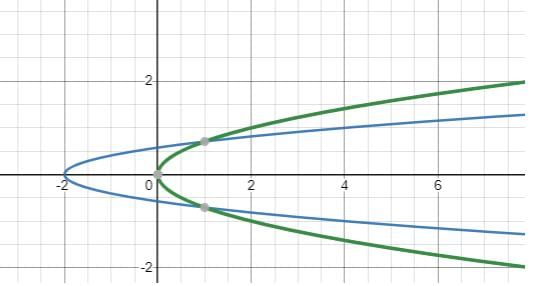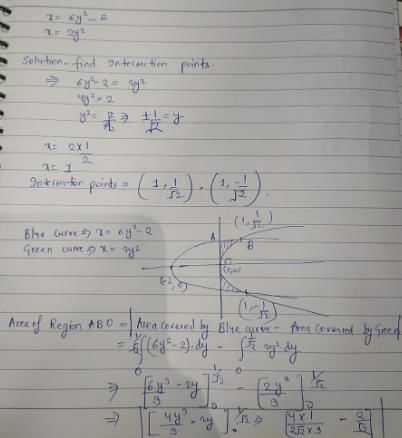IIT JAM Exam > IIT JAM Questions > The area of the planar region bounded by the ...
Start Learning for Free
The area of the planar region bounded by the curves x = 6y2 – 2 and x = 2y2 is
- a)4√2/3
- b)2√2/3
- c)√2/3
- d)√2
Correct answer is option 'A'. Can you explain this answer?
Verified Answer
The area of the planar region bounded by the curves x = 6y2 – 2 ...



Hence correct option is A.
Most Upvoted Answer
The area of the planar region bounded by the curves x = 6y2 – 2 ...
And x = 2 + 6y2 is given by:
First, we need to find the intersection points of the two curves:
6y2 = 2 + 6y2
0 = 2
This is a contradiction, so the two curves do not intersect.
Next, we need to find the bounds of the region. To do this, we can find the y-values where each curve is equal to zero:
x = 6y2
y = 0
x = 2 + 6y2
y = ±sqrt((x-2)/6)
Since the curves do not intersect, the region is split into two parts. We can integrate each separately:
For the part of the region where y is between 0 and sqrt((x-2)/6), we integrate x = 6y2 from y = 0 to y = sqrt((x-2)/6):
∫0^(sqrt((x-2)/6)) 6y2 dy = 2(x-2)
For the part of the region where y is between -sqrt((x-2)/6) and 0, we integrate x = 2 + 6y2 from y = -sqrt((x-2)/6) to y = 0:
∫(-sqrt((x-2)/6))^0 (2 + 6y2) dy = 2/3(x-2)
Putting these together, the area of the region is given by:
A = ∫2^(14/3) 2(x-2) dx + ∫14 2/3(x-2) dx
A = 56/3 + 28/3
A = 28
Therefore, the area of the planar region bounded by the curves x = 6y2 and x = 2 + 6y2 is 28 square units.
First, we need to find the intersection points of the two curves:
6y2 = 2 + 6y2
0 = 2
This is a contradiction, so the two curves do not intersect.
Next, we need to find the bounds of the region. To do this, we can find the y-values where each curve is equal to zero:
x = 6y2
y = 0
x = 2 + 6y2
y = ±sqrt((x-2)/6)
Since the curves do not intersect, the region is split into two parts. We can integrate each separately:
For the part of the region where y is between 0 and sqrt((x-2)/6), we integrate x = 6y2 from y = 0 to y = sqrt((x-2)/6):
∫0^(sqrt((x-2)/6)) 6y2 dy = 2(x-2)
For the part of the region where y is between -sqrt((x-2)/6) and 0, we integrate x = 2 + 6y2 from y = -sqrt((x-2)/6) to y = 0:
∫(-sqrt((x-2)/6))^0 (2 + 6y2) dy = 2/3(x-2)
Putting these together, the area of the region is given by:
A = ∫2^(14/3) 2(x-2) dx + ∫14 2/3(x-2) dx
A = 56/3 + 28/3
A = 28
Therefore, the area of the planar region bounded by the curves x = 6y2 and x = 2 + 6y2 is 28 square units.
Free Test
FREE
| Start Free Test |
Community Answer
The area of the planar region bounded by the curves x = 6y2 – 2 ...
I am not able to find it

|
Explore Courses for IIT JAM exam
|

|
Question Description
The area of the planar region bounded by the curves x = 6y2 – 2 and x = 2y2 isa)4√2/3b)2√2/3c)√2/3d)√2Correct answer is option 'A'. Can you explain this answer? for IIT JAM 2025 is part of IIT JAM preparation. The Question and answers have been prepared according to the IIT JAM exam syllabus. Information about The area of the planar region bounded by the curves x = 6y2 – 2 and x = 2y2 isa)4√2/3b)2√2/3c)√2/3d)√2Correct answer is option 'A'. Can you explain this answer? covers all topics & solutions for IIT JAM 2025 Exam. Find important definitions, questions, meanings, examples, exercises and tests below for The area of the planar region bounded by the curves x = 6y2 – 2 and x = 2y2 isa)4√2/3b)2√2/3c)√2/3d)√2Correct answer is option 'A'. Can you explain this answer?.
The area of the planar region bounded by the curves x = 6y2 – 2 and x = 2y2 isa)4√2/3b)2√2/3c)√2/3d)√2Correct answer is option 'A'. Can you explain this answer? for IIT JAM 2025 is part of IIT JAM preparation. The Question and answers have been prepared according to the IIT JAM exam syllabus. Information about The area of the planar region bounded by the curves x = 6y2 – 2 and x = 2y2 isa)4√2/3b)2√2/3c)√2/3d)√2Correct answer is option 'A'. Can you explain this answer? covers all topics & solutions for IIT JAM 2025 Exam. Find important definitions, questions, meanings, examples, exercises and tests below for The area of the planar region bounded by the curves x = 6y2 – 2 and x = 2y2 isa)4√2/3b)2√2/3c)√2/3d)√2Correct answer is option 'A'. Can you explain this answer?.
Solutions for The area of the planar region bounded by the curves x = 6y2 – 2 and x = 2y2 isa)4√2/3b)2√2/3c)√2/3d)√2Correct answer is option 'A'. Can you explain this answer? in English & in Hindi are available as part of our courses for IIT JAM.
Download more important topics, notes, lectures and mock test series for IIT JAM Exam by signing up for free.
Here you can find the meaning of The area of the planar region bounded by the curves x = 6y2 – 2 and x = 2y2 isa)4√2/3b)2√2/3c)√2/3d)√2Correct answer is option 'A'. Can you explain this answer? defined & explained in the simplest way possible. Besides giving the explanation of
The area of the planar region bounded by the curves x = 6y2 – 2 and x = 2y2 isa)4√2/3b)2√2/3c)√2/3d)√2Correct answer is option 'A'. Can you explain this answer?, a detailed solution for The area of the planar region bounded by the curves x = 6y2 – 2 and x = 2y2 isa)4√2/3b)2√2/3c)√2/3d)√2Correct answer is option 'A'. Can you explain this answer? has been provided alongside types of The area of the planar region bounded by the curves x = 6y2 – 2 and x = 2y2 isa)4√2/3b)2√2/3c)√2/3d)√2Correct answer is option 'A'. Can you explain this answer? theory, EduRev gives you an
ample number of questions to practice The area of the planar region bounded by the curves x = 6y2 – 2 and x = 2y2 isa)4√2/3b)2√2/3c)√2/3d)√2Correct answer is option 'A'. Can you explain this answer? tests, examples and also practice IIT JAM tests.

|
Explore Courses for IIT JAM exam
|

|
Signup for Free!
Signup to see your scores go up within 7 days! Learn & Practice with 1000+ FREE Notes, Videos & Tests.


















